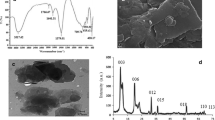Abstract
Human flavin-containing monooxygenases are the second most important class of drug-metabolizing enzymes after cytochromes P450. Here we report a simple but functional and stable enzyme-electrode system based on a glassy carbon (GC) electrode with human flavin-containing monooxygenase isoform 3 (hFMO3) entrapped in a gel cross-linked with bovine serum albumin (BSA) by glutaraldehyde. The enzymatic electrochemical responsiveness is characterised by using well-known substrates: trimethylamine (TMA), ammonia (NH3), triethylamine (TEA), and benzydamine (BZD). The apparent Michaelis–Menten constant (K′M) and apparent maximum current (I′max) are calculated by fitting the current signal to the Michaelis–Menten equation for each substrate. The enzyme-electrode has good characteristics: the calculated sensitivity was 40.9 ± 0.5 mA mol−1 L cm−2 for TMA, 43.3 ± 0.1 mA mol−1 L cm−2 for NH3, 45.2 ± 2.2 mA mol−1 L cm−2 for TEA, and 39.3 ± 0.6 mA mol−1 L cm−2 for BZD. The stability was constant for 3 days and the inter-electrode reproducibility was 12.5%. This is a novel electrochemical tool that can be used to investigate new potential drugs against the catalytic activity of hFMO3.




Similar content being viewed by others
References
Cashman JR (1995) Chem Res Toxicol 8(2):166–181
Cashman JR (2004) Drug Discov Today 9(13):574–581
Cashman JR (2008) Expert Opin Drug Metab Toxicol 4(12):1507–1521
Krueger SK, Williams DE (2005) Pharmacol Ther 106(3):357–387
Phillips IR, Dolphin CT, Clair P, Hadley MR, Hutt AJ, McCombie RR, Smith RL, Shephard EA (1995) Chem Biol Interact 96(1):17–32
Cashman JR (2002) Drug Metab Rev 34(3):513–521
Cashman JR (2000) Curr Drug Metab 1(2):181–191
Schlaich NL (2007) Trends Plant Sci 12(9):412–418
Cashman JR (2005) Biochem Biophys Res Commun 338(1):599–604
Motika MS, Zhang J, Zheng X, Riedler K, Cashman JR (2009) Mol Genet Metab 97(2):128–135
Koukouritaki SB, Simpson P, Yeung CK, Rettie AE, Hines RN (2002) Pediatr Res 51(2):236–243
Mitsubayashi K, Hashimoto Y (2002) Sens Actuators B 83(1–3):35–40
Saito H, Kaneko Y, Hashimoto Y, Shirai T, Mitsubayashi K (2006) Int J Environ Anal Chem 86(14):1057–1064
Saito H, Kaneko Y, Hashimoto Y, Shirai T, Kudo H, Otsuka K, Mitsubayashi K (2007) Sens Actuators B 123(2):877–881
Mitsubayashi K, Kubotera Y, Yano K, Hashimoto Y, Kon T, Nakakura S, Nishi Y, Endo H (2004) Sens Actuators B 103(1–2):463–467
Saito H, Shirai T, Kudo H, Mitsubayashi K (2008) Anal Bioanal Chem 391(4):1263–1268
Fillit C, Jaffrezic-Renault N, Bessueille F, Leonard D, Mitsubayashi K, Tardy J (2008) Mat Sci Eng C-Biomim 28(5–6):781–786
Yeung CK, Adman ET, Rettie AE (2007) Arch Biochem Biophys 464(2):251–259
Lang DH, Yeung CK, Peter RM, Ibarra C, Gasser R, Itagaki K, Philpot RM, Rettie AE (1998) Biochem Pharmacol 56(8):1005–1012
Störmer E, Roots I, Brockmöller J (2000) Br J Clin Pharmacol 50(6):553–561
Sadeghi SJ, Meirinhos R, Catucci G, Dodhia VR, Di Nardo G, Gilardi G (2010) J Am Chem Soc 132:458–459
Guerrieri A, De Benedetto GE, Palmisano F, Zambonin PG (1995) Analyst 120(11):2731–2736
Dolphin CT, Janmohamed A, Smith RL, Shephard EA, Phillips IR (1997) Nat Genet 17(4):491–494
Yeung CK, Rettie AE (2006) Methods Mol Biol 320:157–162
Dong J, Porter TD (1996) Arch Biochem Biophys 327(2):254–259
Macheroux P (1999) in: Chapman SK, Reid GA (eds) Flavoprotein Protocols: Methods in Molecular Biology, Humana Press, Totowa pp. 1–7
Verhagen MFJM, Hagen WR (1992) J Electroanal Chem 334:339–350
Wei H, Omanovic S (2008) Chem Biodivers 5(8):1622–1639
Schoenwald RD, Kumakura T, Catanese B (1987) Int J Tissue React 9(2):93–97
Acknowledgements
The authors would like to acknowledge financial support from the EU project (MRTN-035649), PRINMIUR 2007 and Regione Piemonte CIPE 2006. We thank Professor Todd D. Porter (University of Kentucky, USA) for the generous gift of pJL2 plasmid.
Author information
Authors and Affiliations
Corresponding author
Rights and permissions
About this article
Cite this article
Castrignanò, S., Sadeghi, S.J. & Gilardi, G. Electro-catalysis by immobilised human flavin-containing monooxygenase isoform 3 (hFMO3). Anal Bioanal Chem 398, 1403–1409 (2010). https://doi.org/10.1007/s00216-010-4014-z
Received:
Revised:
Accepted:
Published:
Issue Date:
DOI: https://doi.org/10.1007/s00216-010-4014-z




